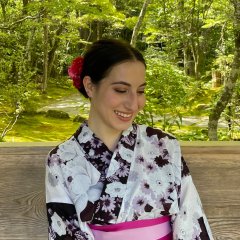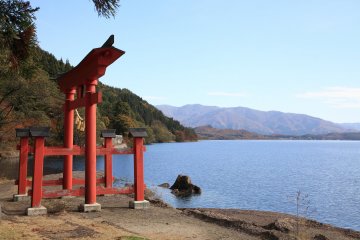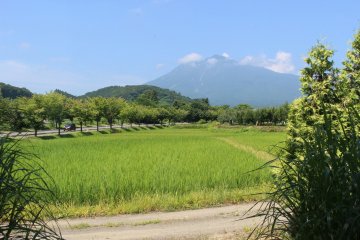Indulge your artist’s eye and cultural curiosities in Akita Prefecture!
Located in Japan’s northern Tohoku region, Akita is renowned for its natural beauty, rejuvenating hot springs, delectable cuisine, adorable dog breed Akita Inu, vibrant art scene, and treasured cultural customs. Let’s shine a spotlight on the latter two.
Since Akita was historically separated from central Japan’s happenings by distance and mountains, it developed a unique cultural heritage. Today, it contains an intriguing repertoire of folktales with helpful, yet frightening demon-like creatures, preserved samurai streetscapes, delicate wood crafting techniques, and time-honored festivals. Art-wise, the prefecture’s museums showcase works by Akita-related, Japanese, and international artists, providing a range of visual delights.
Discover the prefecture’s top art and cultural destinations below!
Access to Akita City
From Tokyo, you can reach Akita City by train or plane. Tokyo Station to Akita Station is about four hours via the JR Akita Shinkansen, and flights from Tokyo’s Haneda Airport to Akita Airport are about 70 minutes. Please refer to the end of each destination for additional access information.
Art: Impressive collections, manga culture, and architecture
Akita Museum of Art

The Akita Museum of Art was established in 2012 as the relocation of the previous prefectural art museum and officially opened in 2013. This visually mesmerizing facility, located beside Senshu Park in Akita City’s center, primarily showcases art from the Masakichi Hirano Art Foundation’s collection, which is best known for its works by acclaimed Japanese-French painter Tsuguharu Foujita.

As a facility established to display the arts, the museum itself is a work of art. Designed by famous Japanese architect Tadao Ando, the museum has a sleek, concrete composition with numerous triangle motifs that serve as an homage to the previous museum’s triangular roof. This sentiment is perhaps best captured in the museum’s entrance area, where a commanding triangle atrium softly illuminates a spiral staircase. In the museum’s lounge area on the second floor, you can admire views of Senshu Park and the former art museum through floor-to-ceiling windows with a gentle water feature in the foreground.
As stated previously, the museum’s greatest pride is its collection of works by Tsuguharu Foujita, who is characterized by his fusion of Japanese and European art styles. The Tsuguharu Foujita Gallery displays a number of his paintings; however, its most eye-catching artwork is “Akita Events,” a 20.5-meter long oil painting that beautifully captures Akita’s seasonal changes and concurring festivals. The museum’s third floor has two additional galleries reserved for various other artists and special exhibitions.
Access: About a 12-minute walk from Akita Station.
Yokote Masuda Manga Museum

Resting in southeastern Akita in Yokote, the Yokote Masuda Manga Museum is heralded as Japan’s first museum with the theme of “original manga drawings.” With its impressive collection of more than 480,000 original drawings, the museum aims to share the appeal of manga culture by preserving and exhibiting these artworks.
The museum’s exterior, with its simple gray color palette and symmetrical design, feels like a two-dimensional drawing imagined in the real world. Inside, the facility’s predominantly white aesthetic allows the exhibited works to take center stage.
The permanent exhibition area starts on the first floor and follows a sloped walkway to the second floor. The gallery proudly displays original drawings from more than 100 manga artists and regularly changes its exhibited works so visitors can discover new artists. The museum’s special exhibition gallery houses multi-month exhibitions that cover a range of topics.
In addition to its exhibition rooms, the museum also has numerous educational and hands-on areas. For instance, there is a manga library with approximately 25,000 manga, and you can often find works directly related to the permanent and special exhibitions. Be sure to check out the library’s Akita corner for manga created by Akita-born artists. Another fun spot is the manga cafe, which serves seasonal dishes and collaboration menus related to the special exhibitions.
Access: From Akita Station, take the Ou Line to Jumonji Station (about one hour and 40 minutes). You can also take the Ou Line from Yokote to Jumonji Station (about 15 minutes). From Jumonji Station, take a bus (Iwaigawa or Yokote-Oyasu Line) to Masuda Kura Station (about 10 minutes). Then, walk for about eight minutes.
Akita Museum of Modern Art

Also located in Yokote and about a 20-minute car ride from Yokote Masuda Manga Museum, Akita Museum of Modern Art is a facility that primarily collects and exhibits art by Akita-related artists from the late Edo Period (1603-1868) to present day.
The museum’s design instantly conveys its themes of modernity and the arts. Sharp geometric designs meet large collections of windows, and its unconventional appearance exudes creative expression. Outside, you can leisurely explore the museum’s three outdoor sculpture areas filled with animal- and human-themed artworks.

Some of the museum’s most intriguing works are its Early Western-style Japanese paintings, called Akita ranga in Japanese. This short-lived painting style existed from 1773 to 1780 and merges Japanese themes with Western-style techniques, such as shading and perspective. The facility’s collection additionally includes Western paintings, Japanese paintings, prints, crafts, and sculptures. It also regularly holds special exhibitions that showcase works by Japanese and international artists.
Access: From Akita Station, take the Ou Line to Yokote Station (about one- to 1.5-hours). From Yokote Station, take the Asahigaoka Line to Akita Furusato Village (15 minutes). Then, walk for eight minutes. It’s a roughly one-hour car ride.
Culture: Preserved folklore, sites, and customs of the past
Namahage folklore

Every year on New Year’s Eve, the Namahage, which are visiting deities, emerge from the mountain and visit the homes of Oga Peninsula’s residents. After entering a house, they aggressively question the household.
“Are you living an honest life? Are you not being lazy?”
The Namahage then threaten to take lazy people to the mountain. In an attempt to pacify the Namahage, families promise to live better in the new year and serve meals, sake, and mochi (rice cakes) to the ogres. Eventually, the Namahage leave the home peacefully, reminding the residents that they will return again next year. In addition to warning against laziness, the Namahage also bring protection from illness and disasters and a good harvest.
This theatrical event, Oga no Namahage, is one of Oga Peninsula’s most beloved customs and was designated as a UNESCO Intangible Cultural Heritage in 2018. The Namahage themselves are played by young men dressed in demonic masks and traditional straw attire.
The Namahage return on the second Friday, Saturday, and Sunday of every February for the Namahage Sedo Festival, which combines Namahage folklore with a Shinto festival. Held at Shinzan Shrine, the fantastical event starts in the evening with Yunomai—sacred kagura dances specific to Oga Peninsula—followed by Chinkamasai, a purification ceremony. Next, the Namahage enter the shrine. In the flickering light of a bonfire, the fearsome, yet revered deities perform a spirited dance and then hold a soul-touching taiko drum performance. Lastly, 15 Namahage descend the night-cloaked mountain with torches. After receiving mochi roasted in the shrine’s bonfire, the Namahage return to the mountain.
If you miss these two Namahage-centered events, you can still experience the unique folklore at the Namahage Museum and the adjacent Oga Shinzan Folklore Museum. The Namahage Museum showcases the history and culture of the Namahage and exhibits a variety of chilling Namahage masks used across Oga Peninsula. The Oga Shinzan Folklore Museum, located in a traditional home, holds numerous performances daily of a typical Namahage visit on New Year’s Eve. Together, both museums offer you a glimpse into this time-honored tradition.
Access: From Akita Station, take the Ou Line to Oga Station (about one hour). Then, take the Namahage Shuttle to the Namahage Museum (25 minutes). It’s a roughly one-hour car ride.
Kakunodate Samurai Residences Street

Experience the ambience of the Edo Period with a nostalgic stroll on the Kakunodate Samurai Residences Street! Situated in Semboku City and known as the “Little Kyoto of Michinoku,” this street stands as one of Japan’s best examples of samurai architecture. During the Edo Period, Kakunodate prospered as a castle town, and today, it is home to multiple samurai residences that are designated as nationally protected Traditional Buildings. The traditional architecture, black wooden walls that flank the street, and lush greenery create a picture-perfect scenery of times past.

Six of the samurai residences are open to the public, allowing you to gain additional insight into the lives of samurai. Two of the area’s most noteworthy homes are Aoyagi House—a large complex that contains museum collections, restaurants, and gift shops—and Ishiguro House, the area’s oldest home and a representation of the highest class of samurai.

This scenic district shines in all seasons, from its fiery autumn hues to its snow-touched sceneries and verdant summer leaves. However, its most popular season is spring when hundreds of cherry blossoms color the area in pastel tones.
Access: From Akita Station take the JR Akita Shinkansen to Kakunodate Station (45 minutes). Then, walk for 18 minutes. It’s a roughly one-hour car ride.
Magewappa-making workshop

Originating in the northern city of Odate, Magewappa is a traditional bentwood craft characterized by its simple and elegant design. These timeless bento boxes showcase the natural grain of Akita cedars, are lightweight, and have a beautiful curved shape. To obtain the Magewappa’s iconic shape, craftspeople boil the cedar to make it pliable and then carefully bend it. The wood is then secured with joints made from the bark of cherry wood, adding a beautiful contrast to the cedar’s light tone. The process of making Magewappa requires both patience and skill.

If you are interested in creating your own Magewappa, you can join a workshop at Shibata Yoshinobu Shoten Wappa Building Store. This immersive experience includes bending the cedar and securing it with cherry bark joints. You will also have the chance to use Magewappa-making tools, such as a wooden mallet, saw, and Japanese-style hand plane. Choose between a round bento box or a bread plate, and craft a functional souvenir that will surely elevate any meal placed within or upon it. Please note that you must make a reservation in advance to attend the workshop.
Access: From Akita Station, take the Ou Line (two hours) or Ou Line-Limited Express (1.5 hours) to Odate Station. Then, walk for four minutes. It’s about a one hour and 45-minute car ride.
Festivals
Since we already touched upon some of Akita’s renowned winter festivals, let’s shed light on its summer ones, namely the Omagari Fireworks and Hanawa-bayashi.

Held in Daisen City on the last Saturday of August, the Omagari Fireworks event is one of Japan’s three major fireworks festivals and is the country’s premier fireworks competition—attracting more than 600,000 people each year. During this competition, Japan’s leading pyrotechnicians come together for an epic showdown, resulting in a mesmerizing display of their skills and creativity.
To enter the venue, you must purchase a ticket in advance, which includes a paid seat. There are various types of seats, such as table seats, chair seats, and leisure sheet seats. All of the seats inside the venue are reserved.
Access: From Akita Station, take the Ou Line to Omagari Station (50 minutes). Then, walk for 25 minutes. It is about a 50-minute car ride. However, given the difficulty with parking and congestion, we recommend public transportation.

Hanawa-bayashi, held annually in Kazuno City on August 19 and 20, is a lively, music-oriented festival with more than 200 years of history. During this two-day extravaganza, regional musicians parade through the city on 10 lavish floats called yataii and fill the streets with traditional melodies. Given its historic prestige, the event was designated as an Intangible Folk Cultural Asset of Akita Prefecture in 1978.
Access: From Akita Station, take the Ou Line to Odate Station (about one hour and 40 minutes to two hours). Then, take the Hanawa Line to Kazuno Hanawa Station (about one hour). It’s about a two hour and 15 minute-drive. However, again, we recommend that you use public transportation due to congestion.
Discover Akita’s art and culture for yourself
Akita’s refined art museums and distinctive cultural heritage make it a fascinating destination where you can discover new perspectives of Japan. With its array of introspective, educational, and high-energy sites, you are guaranteed to find something that resonates with you or sparks your curiosity.
If you are interested in learning more about this northern gem, please check out our Akita Feature Page!



























